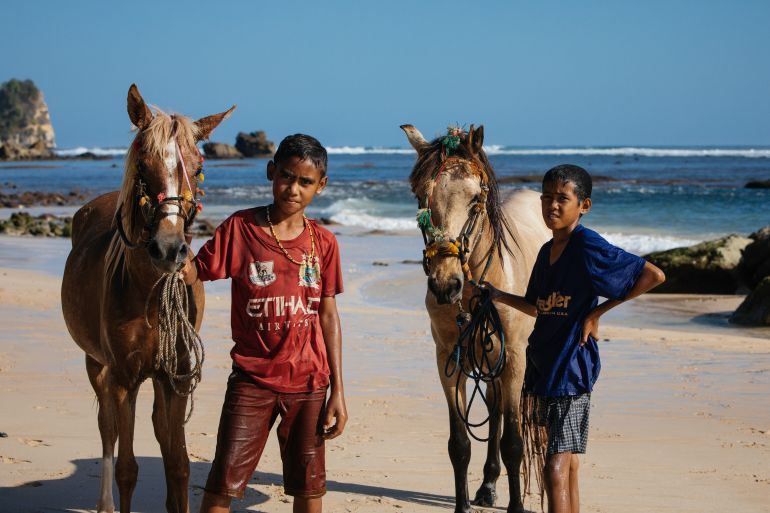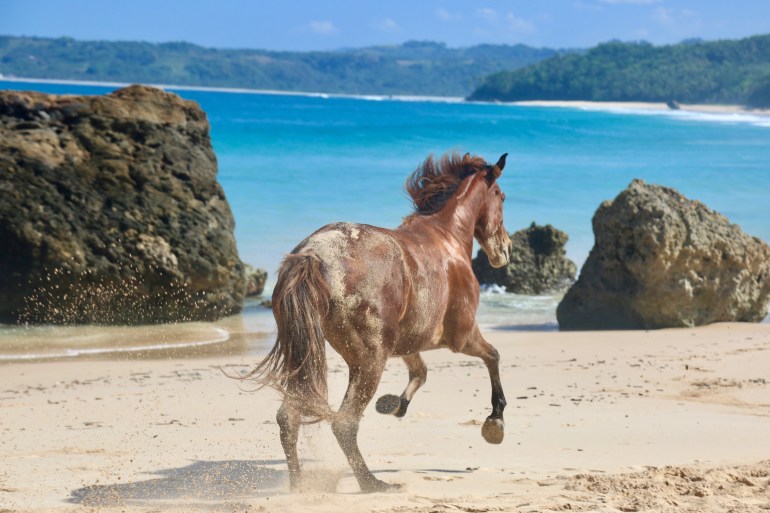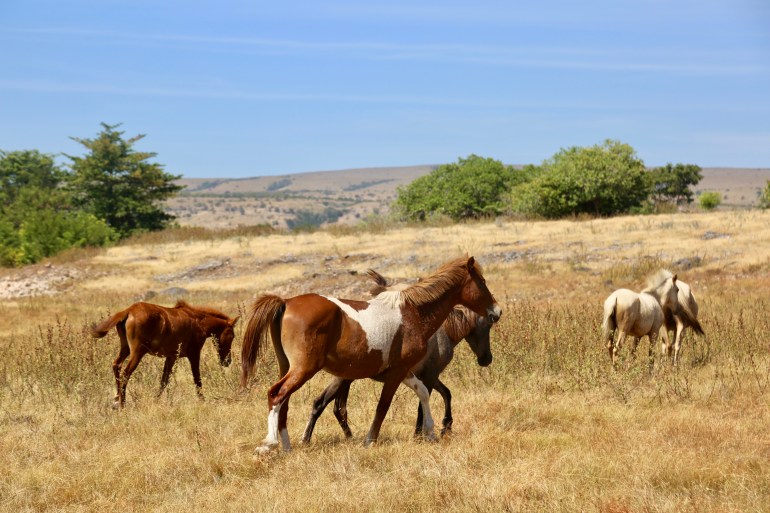A ride to heaven: Why Sumba loves the Sandalwood pony
The lineage of the trusty Sandalwood pony dates back to the 8th century and is central to the Indonesian island’s culture.

Sumba, Indonesia – Named after the scented trees that once covered the island, the Sandalwood pony of Sumba is the only breed of horse in Indonesia that is still intrinsic to the local economy, culture and religion.
A spirited and nimble animal with good stamina and a friendly disposition, the Sandalwood pony is also the only breed of horse in Indonesia that is exported overseas: as children’s ponies in Australia and racehorses in Singapore, Malaysia and other parts of Southeast Asia. They are also sought after by abattoirs in the Indonesian province of Sulawesi where horse meat is a delicacy.
Keep reading
list of 4 itemsIn Pictures: Mining tin from the sea in Indonesia
Months at sea: Boat carrying Rohingya washes up in Indonesia
Indonesia cancels Hajj again amid concerns over COVID
But the proliferation of motorbikes coupled with perennial drought in Sumba, some 800km (497 miles) east of Bali, is forcing more people to migrate from rural to urban areas and some worry the pony is being left behind.
“Motorbikes are now more valuable than horses on this island,” says Claude Graves, an American hotelier and philanthropist who has lived on and off in Sumba for 40 years.
“The culture is dying. Only the Pasola has been keeping it going,” he added, referring to the annual festival held at the start of the rice-planting season at which mounted riders pelt spears at one another to ostensibly fertilise the soil with human blood. The spears are now blunted but fatalities of riders and spectators still occur.
Petrus Ledibani, assistant stable manager at Nihi Sumba, a luxury resort that offers a variety of horse-based activities, says when his father was young, every Sumbanese child could ride.

“But now many children have never even sat on a horse – only those whose families own horses or are involved with horse racing know how to ride,” he said.
Horse trading
One of eight official horse breeds gazetted in Indonesia, Sandalwood ponies have small ears, a short muscular neck and an unusually long back. Their lineage dates back to the eighth century when traders from China first visited Indonesia.
“They’re called Sandalwood ponies because the Chinese swapped Mongolian ponies for sandalwood with the locals,” Carol Sharpe, an expert in natural horsemanship from Australia who founded the stables at Nihi Sumba told Al Jazeera. “Later they were bred with Arabian horses brought by traders from the Middle East. The Arabian is naturally a very flighty horse while the Mongolian is also fast but stockier with more stamina, so it’s a very good mix. But they’re not good for labour because of their small stature, probably because of centuries of malnourishment. There’s lots of grass on the island but most of it is not nutritious.”
But the Sumbanese, who practise Catholicism or Islam peppered with animism, found plenty of other uses for the ponies: transport, status symbols, dowry payments, sacrifices for funerals and as vehicles to store wealth.
In the 1930s, Dutch colonists introduced circuit-style horse racing to the island.
A racehorse breeding industry that crosses Sandalwood ponies with Australian Thoroughbreds also emerged and is now dominated by Indonesians of Chinese heritage. But many breeders in Sumba have little concern for the welfare of their animals, according to Sharpe.
“The crossbreeds develop a lot of back problems due to being started racing too early. I’ve seen foals as young as 12 or 18 months on the track. They also interfere with them, inject steroids and feed them energy drinks or coffee before races,” she said.

“More also let their horses run wild in the lean times to save money on feed. They don’t tend to last long. In 2019 we had a horrible drought. Horses were dropping like flies.”
Instagram sensation
Despite their general poor health, Sharpe recognises the larger-built Thoroughbred-Sandalwood crossbreeds are better suited for activities at the resort than Sandalwood ponies, and went about building a herd.
“They’d been trained to run by using fear tactics so at first they were uncontrollable. Anyone who tried to ride them would end up on the ground,” she said. “That’s where my work in natural horsemanship helped slow them down for sunset rides along the beach – skills I passed onto the stable boys.”
Sharpe learned new skills from her stable boys, too, specifically, how to wash the animals by taking them into the surf, sometimes with riders on their back. Over time the bathing ritual evolved into a dedicated activity at the resort.
When guests took photos and shared them online, the swimming horses went viral on Instagram.
“Sumba was always known in Indonesia as the land of horses,” said Jonathan Hani, a horse breeder in Sumba’s sleepy capital Waingapu. “But when guests at Nihi started swimming with horses and people saw the photos overseas, the exposure was very good for us. It put Sumba on the map. We got a lot more international tourists.”
View this post on Instagram
Resort manager Madlen Ernest also credits the horses with keeping the property afloat during the coronavirus pandemic and putting food on the tables of more than 300 employees.
“Before the pandemic, nearly all of our guests were foreigners so when the international travel ban was introduced in April, we had to close,” she said.
“Four months later we reopened targeting the Indonesian market. At first we weren’t sure if it would work, but things picked much faster than expected because some of the Indonesian influencers who stayed here reposted photos of horses swimming on Instagram.”
A ride to heaven
The Sumba Foundation, a charity that provides potable water, healthcare, nutrition and education to about 35,000 people on the island, has also capitalised on tourists’ appreciation for horses on Sumba.
“We get kids from the villages to come down to the beach with their horses for races. Tourists buy tickets to place bets on their favourites and all the winning go towards specific projects,” said general manager Patrick Compau. “At our last race, we raised $4,400 for a little girl with a rare genetic defect in her intestines who needs surgery in Bali to save her life.”
Adds Claude Grave, the charity’s founder: “We’re seeing kids as young as eight turning up to compete, all proud. It’s great that we can raise money but for me, the kids’ races are all about preserving the culture.”
Despite the recent changes in Sumba life, horse breeder Hani believes the Sandalwood pony will always be part of the island’s culture.
“They’re no longer used by most people for transport because motorbikes are more convenient but they’re still used in every part of our culture,” he said. “When a boy wants to marry a girl, they have to give her parents horses. When someone dies, the family must sacrifice a horse because we believe it will take their soul to heaven.
“Horses are our best friends in Sumba, a part of the family,” he says. “Owning one is a symbol of pride. If a person has a horse, it means they are of good character.”